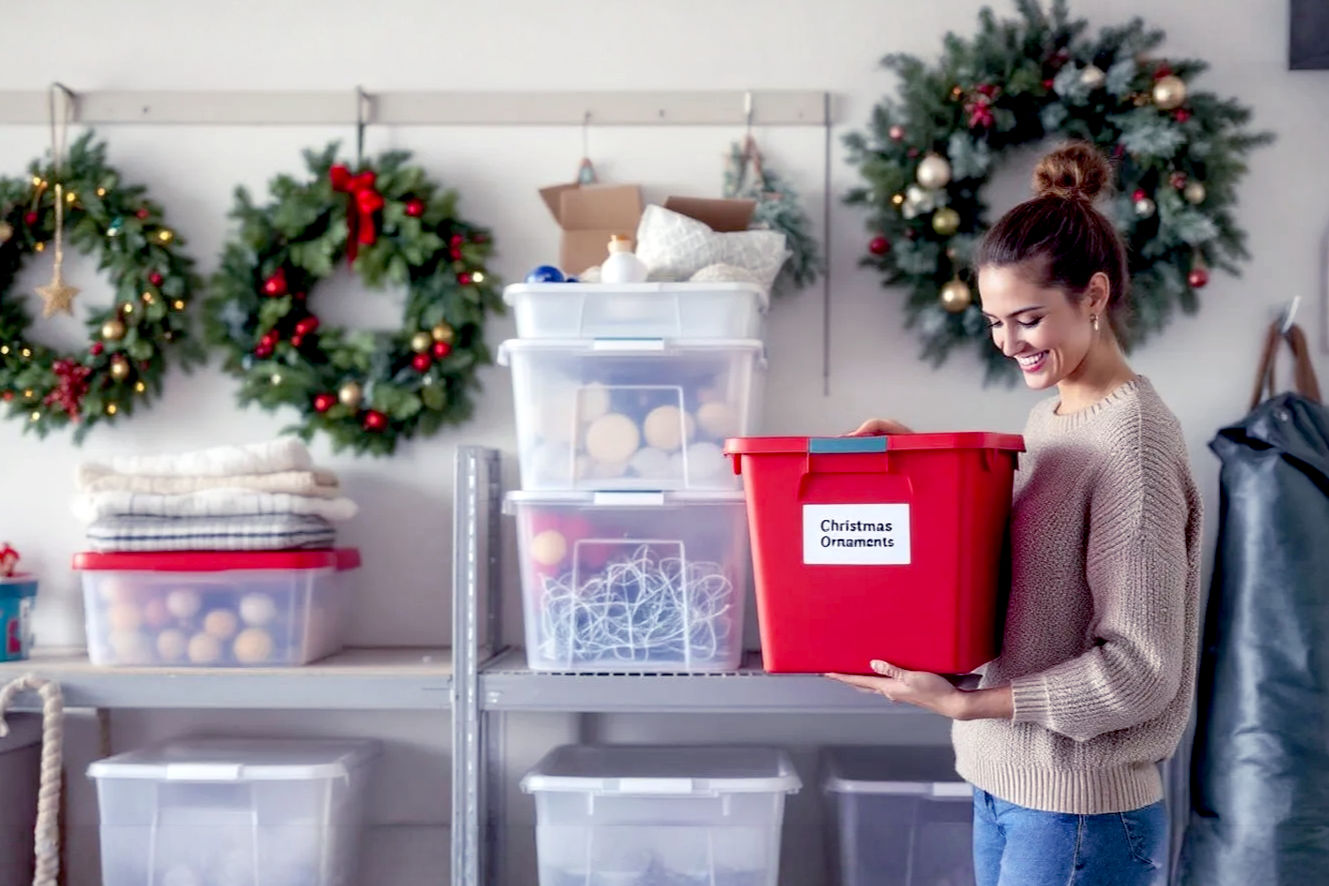This post may contain affiliate links. If you make a purchase through these links, we may earn a commission at no additional cost to you.
Christmas cards aren’t just paper and ink; they’re tiny time capsules filled with love, laughter, and memories from friends and family. Each card represents a connection, a shared moment, and a piece of your personal history. But after the holidays are over, what do you do with them? Tossing them feels wrong, but letting them pile up creates clutter. The good news is that there are many creative and effective ways to store your Christmas cards, not just to keep them tidy, but to preserve their sentimental value for years to come.
The Importance of Preserving Christmas Cards
Before diving into storage solutions, it’s worth understanding why preserving these cards matters. Many people view Christmas cards as temporary decorations, enjoyed for a few weeks and then discarded. However, they are far more significant than that.
More Than Just a Greeting
Each card often contains handwritten messages, personal updates, and even photographs. These elements offer a unique snapshot of a particular year and the relationships you cherish. Think about it: a card from a grandparent might be one of the last handwritten notes you receive from them. A card from a faraway friend could be a rare update on their life. Over time, these seemingly small items become priceless mementos.
A Glimpse into the Past
Collecting and storing Christmas cards allows you to track your family’s history and the history of your relationships. Imagine looking back through cards from decades past. You’ll see how families have grown, how handwriting has changed, and how holiday traditions have evolved. They provide a tangible link to your past, helping you reconnect with cherished memories and the people who sent them. This isn’t just about nostalgia; it’s about honoring the connections that shape your life.
Understanding the Enemies of Preservation: What Damages Paper?
To effectively preserve your Christmas cards, you need to know what can damage them. Paper, despite its seemingly robust nature, is susceptible to several environmental factors. Understanding these “enemies” helps you choose the best storage methods and materials to protect your precious cards.
Light: The Fading Factor
One of the most significant threats to paper is light, particularly ultraviolet (UV) light. Whether from direct sunlight or even fluorescent indoor lighting, UV rays can cause inks to fade and paper to become brittle. This process, known as photodegradation, breaks down the chemical bonds in the dyes and paper fibers.
- Sunlight: Direct sunlight is the most damaging. Even a few hours of exposure can begin the fading process.
- Fluorescent Lights: While less intense than sunlight, fluorescent lights still emit UV radiation that can harm paper over time.
- Incandescent Lights: These are generally safer as they emit very little UV, but prolonged exposure can still contribute to minor fading and heat damage.
To combat light damage, store cards in opaque containers or areas away from direct light sources. If you display cards, rotate them often or use UV-protective sleeves or frames.
Temperature and Humidity: The Moisture Menace
Paper is hygroscopic, meaning it readily absorbs moisture from the air. Both high temperature and high humidity can wreak havoc on your stored cards.
- High Humidity: A relative humidity (RH) above 60% creates a perfect breeding ground for mold and mildew. These fungi feed on the paper itself, leaving unsightly stains and a musty odor. High humidity also causes paper to swell and warp.
- High Temperatures: Heat speeds up chemical reactions. When combined with humidity, high temperatures accelerate the degradation of paper, making it brittle and discolored.
- Fluctuations: Rapid changes in temperature and humidity are even worse than consistently high or low levels. These fluctuations cause the paper to repeatedly expand and contract, leading to stress, warping, and cracking.
Ideally, cards should be stored in an environment with a stable temperature between 68-72°F (20-22°C) and a relative humidity between 30-50%. Basements and attics are often poor choices for long-term storage due to their fluctuating and often extreme conditions.
Pests: The Unwanted Guests
Insects and rodents love paper. Silverfish, cockroaches, booklice, and even common house pests like mice can feast on paper and adhesives, leaving behind irreparable damage.
- Silverfish and Booklice: These tiny insects thrive in damp, dark environments and consume paper, glue, and mold. They leave behind irregular holes and yellow stains.
- Cockroaches: They’ll eat almost anything, including paper, leaving irregular chewing marks and brown stains.
- Rodents (Mice, Rats): Rodents chew through paper to create nests and can contaminate your collection with droppings and urine.
To deter pests, keep storage areas clean and dry. Avoid storing cards directly on the floor. Use pest-resistant containers and consider archival-grade boxes made from materials that are less appealing to pests.
Acid: The Self-Destruction Enzyme
This is perhaps the most insidious enemy of paper. Most commercially produced paper contains lignin (a natural polymer found in wood pulp) and is processed with acidic chemicals. Over time, these residual acids react with moisture and oxygen in the air, causing the paper to become brittle, yellow, and eventually crumble. This process is called acid hydrolysis.
- Lignin: Paper made from wood pulp that hasn’t had its lignin removed will naturally degrade. Lignin breaks down into acids, which then attack the cellulose fibers that give paper its strength.
- Processing Chemicals: Bleaching agents and sizing agents used in paper production can also be acidic.
To prevent acid damage, use acid-free and lignin-free storage materials. This includes archival-grade boxes, folders, and sleeves. These materials are specifically designed to be chemically stable and won’t contribute to the degradation of your cards. Look for products labeled “acid-free” or “archival quality.”
Preparation is Key: Cleaning and Organizing Your Cards
Before you even think about putting your cards into storage, a little preparation goes a long way. Proper cleaning and organization will ensure your cards are in the best possible condition for long-term preservation.
Initial Inspection and Cleaning
Take the time to go through each card individually. This is your chance to remove any potential damaging elements and get them ready for storage.
- Remove Envelopes and Inserts: While the envelope can provide context (like the sender’s address or postmark date), they often contain adhesives that can degrade over time and potentially leach acids onto the card itself. If you want to keep the envelope, store it separately or use a protective sleeve for the card. Remove any loose inserts, photos, or glitter that might scratch or damage other cards.
- Gentle Cleaning: If a card has light surface dirt or dust, gently wipe it with a soft, dry microfiber cloth. For more stubborn grime (like pencil marks), a kneaded eraser can be very effective without damaging the paper. Avoid using liquid cleaners, as they can cause inks to bleed or paper to warp.
- Flattening and Repair: If cards are bent or creased, you can gently flatten them. Place them between two pieces of acid-free paper and under a heavy, flat object for a few days. For minor tears, use archival-quality tape (specifically designed for paper repair, like document repair tape), but only if absolutely necessary and sparingly. Avoid common household tapes, as their adhesives degrade and can stain paper.
Organizing for Easy Access and Preservation
How you organize your cards impacts both their accessibility and their longevity. A structured approach makes it easier to find specific cards and protects them from damage caused by haphazard storage.
- Categorization: Consider how you want to categorize your cards. Common methods include:
- By Year: This is a popular choice for tracking family history and seeing how cards evolve.
- By Sender: Grouping cards from specific friends or family members allows you to easily revisit their messages.
- By Theme: Less common for Christmas cards, but useful if you have a collection of cards with a particular artistic style or subject.
- Dating Cards: If a card isn’t dated, try to determine the year it was received. You can write the year lightly in pencil on the back of the card, using an archival-safe pencil. This small step will be invaluable in the future.
- Handling with Care: Always handle cards with clean, dry hands. Oils and dirt from your skin can transfer to the paper and cause deterioration over time. If you have particularly delicate or valuable cards, consider wearing cotton gloves when handling them.
Top Creative Christmas Card Storage Ideas
Now for the fun part: exploring different ways to store your cherished Christmas cards. These methods range from practical and protective to decorative and display-worthy, ensuring your memories are preserved and enjoyed.
1. Archival Boxes and Binders: The Gold Standard for Protection
For serious preservation, archival-grade storage is the undisputed champion. These materials are specifically designed to protect paper from the elements discussed earlier.
Archival Storage Boxes
These are made from acid-free, lignin-free, and buffered materials. Buffering agents, often calcium carbonate, are added to neutralize any acids that might form over time or be present in the cards themselves.
- Types:
- Flat Storage Boxes: Ideal for larger cards or collections you want to lay flat to prevent warping. They often come with dividers.
- Document Boxes: Taller boxes designed for upright storage, similar to file boxes.
- Photo Storage Boxes: Often smaller and designed for 4×6 or 5×7 cards, sometimes with individual card sleeves.
- Benefits:
- Superior Protection: Shields cards from light, dust, pests, and environmental acidity.
- Long-Term Preservation: Ensures cards remain in excellent condition for decades.
- Organization: Many come with dividers or internal compartments for easy sorting.
- Considerations:
- Cost: Generally more expensive than regular storage boxes.
- Availability: May need to be purchased from specialized archival supply stores or online retailers.
- Technical Detail: Look for boxes that meet PAT (Photographic Activity Test) standards. This certification indicates that the materials have been tested and proven not to negatively interact with or degrade photographic materials, making them ideal for cards with photos or glossy finishes. The material typically used is alkaline-buffered board, which has a pH value above 7.0 (neutral) and often around 8.5-9.5 to provide a “buffer” against future acidification.
Archival Binders and Sleeves
Another excellent option, particularly for viewing your collection, involves archival binders combined with acid-free page protectors.
- Types of Sleeves:
- Polypropylene: A stable plastic that is safe for long-term storage. Look for “acid-free” and “archival safe.”
- Mylar (BoPET): A very stable polyester film, excellent for long-term preservation, though generally more expensive.
- PVC (Polyvinyl Chloride): AVOID PVC sleeves at all costs. They off-gas chemicals (plasticizers) that can damage paper, cause ink transfer, and become sticky over time.
- Benefits:
- Easy Viewing: Pages can be flipped through like an album.
- Individual Protection: Each card is protected from handling and adjacent cards.
- Space-Efficient: Binders can be stored neatly on shelves.
- Considerations:
- Size Matching: Ensure sleeves fit your cards snugly to prevent movement.
- Weight: Large binders can become heavy.
- Technical Detail: When selecting sleeves, ensure they are made from uncoated polypropylene or polyester (Mylar) and are specifically labeled “archival safe” and “acid-free.” The thickness (measured in mil, where 1 mil = 0.001 inch) can vary; thicker sleeves generally offer more rigidity and protection. A good range for card sleeves is usually between 3 mil and 5 mil.
2. Photo Albums: A Familiar and Engaging Option
Traditional photo albums, especially those designed for scrapbooking, can be a wonderful way to store and display Christmas cards. They offer a more interactive way to enjoy your collection.
- Magnetic Albums (AVOID): Be very cautious of “magnetic” photo albums from the past. These often have sticky pages covered with plastic film. The adhesive and plastic can be highly acidic and will severely damage your cards over time, causing yellowing, staining, and sticking.
- Safe Photo Albums: Look for acid-free, lignin-free photo albums with pockets or pages designed for mounting photos. These often use polypropylene pockets or archival paper pages.
- Benefits:
- Display-Oriented: Great for sharing your collection with others.
- Creative Freedom: Allows for embellishment and journaling if desired (using archival pens).
- Neat Organization: Keeps cards tidy and protected from dust and handling.
- Considerations:
- Size Limitations: Cards might need to be trimmed or folded if they don’t fit standard album pockets.
- Space: Albums can take up significant shelf space.
- Tip: If using a scrapbook, use only archival-quality adhesives like photo corners, glue dots, or mounting squares. Avoid glues sticks or rubber cement.
3. Decorative Storage Boxes: Style Meets Function
For those who want storage that doubles as home decor, decorative storage boxes are an attractive solution. The key is to ensure they also provide adequate protection.
- Materials: Look for sturdy boxes made from wood, heavy-duty cardboard (acid-free lined), or plastic. Avoid cheap cardboard boxes that may be acidic.
- Features:
- Lids: A tight-fitting lid is crucial to protect from dust, light, and pests.
- Acid-Free Lining: If the box isn’t inherently acid-free, consider lining it with acid-free tissue paper or paper.
- Dividers: Internal dividers help keep cards organized by year or sender.
- Benefits:
- Aesthetic Appeal: Can blend seamlessly with your home decor.
- Accessibility: Easy to open and browse through.
- Versatile: Can be used for other mementos too.
- Considerations:
- Protection Level: May not offer the same level of environmental control as sealed archival boxes.
- Durability: Quality varies widely, so choose well-constructed boxes.
- Placement: Store these boxes in a climate-controlled room, not an attic or basement.
4. Digital Archiving: A Modern Backup
While not a physical storage method, digitizing your Christmas cards is an invaluable step for long-term preservation and accessibility. It creates a backup in case anything happens to your physical collection and allows for easy sharing.
- Process:
- Scanning: Use a flatbed scanner for the best quality. Scan at a high resolution (e.g., 300-600 dpi) for detail. Save in formats like JPEG (for general use) or TIFF (for archival quality).
- Photography: If a scanner isn’t available, a good quality smartphone camera can work. Ensure good lighting and a steady hand.
- Organization:
- Folders: Create organized folders on your computer (e.g., “Christmas Cards 2024,” “Family Cards,” “Friend Cards”).
- Naming Convention: Rename files clearly (e.g., “2024_SmithFamily_Front.jpg,” “2024_SmithFamily_InsideMessage.jpg”).
- Metadata: Add tags or keywords to your digital files (e.g., sender’s name, year, significant events mentioned).
- Backup: Crucially, back up your digital files! Use cloud storage (Google Drive, Dropbox, iCloud), an external hard drive, or both. Follow the 3-2-1 backup rule: 3 copies of your data, on 2 different media types, with 1 copy offsite.
- Benefits:
- Space-Saving: Eliminates the need for physical space.
- Accessibility: View your cards anywhere, anytime.
- Damage Protection: Immune to physical damage, pests, or environmental factors.
- Shareability: Easily share cards with family members.
- Considerations:
- Time Commitment: Scanning a large collection can be time-consuming.
- Quality: The quality of the digital image depends on your equipment and scanning technique.
- Technical Detail: For archival-grade digital images, scan at a minimum of 300 dpi (dots per inch), but 600 dpi or higher is recommended for detailed images or future printing. Save as uncompressed TIFF (Tagged Image File Format) files for maximum quality preservation, as TIFF supports lossless compression. JPEGs, while convenient, use lossy compression, meaning some data is discarded during saving, which can degrade image quality over multiple saves.
Creative Display Ideas for Current and Cherished Cards
While storage is about preservation, display is about enjoying your cards. You can integrate current year’s cards into your decor and even rotate some of your favorite past cards into seasonal displays.
For the Current Year’s Cards:
- Card Garlands: Use small clothespins to attach cards to a string or ribbon hung across a doorway, mantel, or wall. This is a classic, festive way to show off all the greetings you receive.
- Wreath Displays: Attach cards to a simple wreath form using small clips or decorative pins. This turns your collection into a personalized piece of holiday art.
- Tiered Stands or Bowls: Arrange cards artfully in a tiered dessert stand or a large decorative bowl on a coffee table or entryway table.
- Picture Frame Displays: Use empty picture frames or shadow boxes to showcase a selection of cards. You can change them out periodically.
For Cherished Past Cards:
- Memory Album Display: If you’ve organized your cards into an album, keep it on a prominent bookshelf or coffee table where it can be easily accessed and enjoyed.
- Framed Favorites: Choose a few particularly special cards and frame them individually or create a collage in a multi-opening frame. Change these out each year for a fresh look.
- Digital Photo Frames: Load scanned images of your favorite cards onto a digital photo frame. This allows you to cycle through a large collection without taking up physical space.
- Holiday Scrapbook Pages: Dedicate specific scrapbook pages to memorable Christmas cards, adding journaling and other ephemera from that year. This is a creative way to integrate them into a broader family history project.
Long-Term Storage Best Practices: Location and Environment
No matter how good your storage containers are, their effectiveness can be undermined by a poor storage environment. The location where you keep your cards is just as important as the container itself.
Ideal Storage Conditions
The goal is to provide a stable, cool, dry, and dark environment.
- Temperature Stability: Aim for a consistent temperature between 68-72°F (20-22°C). Avoid rooms that experience significant temperature swings throughout the day or year.
- Humidity Control: Maintain a relative humidity (RH) between 30-50%. A hygrometer (a device that measures humidity) can help you monitor this. If humidity is consistently too high, consider a dehumidifier in the storage area. If it’s too low, a humidifier might be needed, but this is less common for general document storage.
- Darkness: Store cards in opaque containers or in a closet or drawer where they are protected from all light sources.
- Cleanliness: Keep the storage area free of dust and debris. Regular cleaning can prevent pest infestations.
- Away from External Walls: Avoid storing valuable items against exterior walls, as these are more susceptible to temperature and humidity fluctuations, as well as potential moisture issues from outside.
Places to Avoid for Storage
Certain areas in your home are notorious for damaging stored items.
- Attics: Often experience extreme temperature fluctuations (very hot in summer, very cold in winter) and can be prone to high humidity, dust, and pests. This is perhaps the worst place for long-term paper storage.
- Basements: While cooler, basements are typically damp and prone to high humidity, mold, and flooding. Ground-level moisture can easily seep in.
- Garages and Sheds: Like attics and basements, these areas lack climate control and are subject to extreme conditions, pests, and often dirt.
- Direct Sunlight/Heat Sources: Never store cards near windows, radiators, vents, or fireplaces. The direct heat and light will rapidly degrade them.
Best Storage Locations
- Interior Closets: Closets within the main living area of your home are usually stable in terms of temperature and humidity. They are also dark.
- Under Beds (in boxes): If the room is climate-controlled, under-bed storage in appropriate containers can work well.
- Dedicated Storage Room/Area: If you have a room that is consistently climate-controlled, it’s an ideal spot.
- Acid-Free Boxes on Shelves: Storing cards in acid-free boxes on shelves, rather than directly on the floor, protects them from potential small floods, spills, or pests.
Maintaining Your Collection: Ongoing Care
Preservation isn’t a one-time task; it’s an ongoing process. Regular maintenance of your Christmas card collection will ensure its longevity.
Periodic Check-ins
- Annual Review: Once a year, perhaps after the holidays when you’re adding new cards, take the time to review your collection.
- Inspect for Damage: Look for any signs of mold, mildew, insect activity, fading, or brittleness. Catching problems early can prevent widespread damage.
- Airing Out: Briefly open storage boxes to allow for some air circulation, especially if they’ve been sealed for a long time. However, don’t leave them open in humid conditions.
Re-Evaluating Storage Methods
- As Your Collection Grows: As your collection expands, you might need to adjust your storage methods. What worked for 50 cards might not work for 500.
- Upgrade Materials: If you started with basic storage, consider upgrading to archival-grade materials as your budget allows or as you identify particularly valuable cards.
- Consider Professional Advice: For extremely valuable or delicate cards, or if you encounter significant damage, consider consulting a professional conservator.
The Value of a “Memory Box” Tradition
Consider creating a yearly “memory box” for your family. This box wouldn’t just hold Christmas cards, but other small mementos from the year: a child’s drawing, a ticket stub from a memorable event, a small newspaper clipping.
- How it Works: At the end of each year, gather all these items (including your Christmas cards for that year) and place them in a clearly labeled archival box.
- Benefits:
- Comprehensive Time Capsule: Creates a rich record of your family’s life year by year.
- Engaging Activity: Involves the whole family in preserving memories.
- Easy Access: When you open a box from a specific year, you have a curated collection of memories at your fingertips.
- Tip: Date the box clearly on the outside with the year or years it covers.
Conclusion: Cherish and Preserve Your Holiday Memories
Christmas cards are more than just seasonal greetings; they are tangible connections to the people and moments that shape our lives. By investing a little time and effort in proper storage and preservation, you’re not just organizing clutter; you’re safeguarding a precious part of your family’s history and ensuring that these heartfelt messages can be revisited and cherished for generations to come. Whether you choose the robust protection of archival boxes, the engaging format of a photo album, or the modern convenience of digital archiving, the goal remains the same: to keep those festive memories alive, year after year. So, this holiday season, as you receive those beautiful cards, remember that you’re holding a piece of your past and future, waiting to be preserved.






